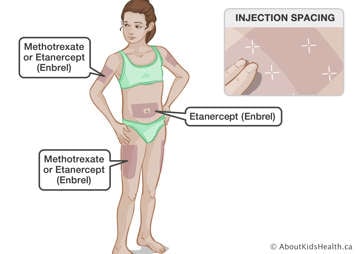There are many ways to take medication. Many medications are taken orally, meaning by mouth. Oral medicines are available in liquid or tablet form. If you are not comfortable swallowing pills, ask your doctor if they are available in a liquid form. If not, see if your doctor or nurse can help you learn ways to make swallowing the pills easier.
Some medications have to be given by injection:
- Some of these medications are given subcutaneously, meaning that they are injected just under your skin. This is much like the insulin shots that people with diabetes take.
- Others are given intravenously (IV), which means they are given through a tiny tube inserted in your vein. The other end of the tube is attached to a bag containing the medication. The medication drips directly into your bloodstream.
- Some medications can be injected directly into your joint. This is called a joint injection or intra-articular injection.
Giving yourself an injection
IV injections and joint injections have to be given by a doctor. However, some injections given under the skin may be done at home. In this case, you or someone at home like your mom or dad will need to learn how to give the injections.
Most people don't like having needles, let alone giving themselves injections. However, many young people find it saves time if they do it themselves. If you are learning to give yourself injections, here are some tips:
Step 1: You need to know how a syringe works. The different parts of a syringe are shown in the picture below.

Step 2: You need to know how to prepare the medication and how to inject it. Check out this animation on how to give an injection.
Step 3: You need to know the areas, or sites, on your body where the injections can be given. Your doctor or nurse will tell you about the best sites to use for your injection. You may find it helpful to use different injection sites so that you don't irritate your skin by using the same site for every injection. Check out the image below to see where you can inject your medication.

Methotrexate can be injected into the upper arms, outer thighs, or in the abdomen. Biologic medications, such as etanercept (Enbrel), adalimumab (Humira), anakinra (Kineret), or canakinumab (Ilaris), can be injected into the upper arms, outer thighs, or in the abdomen. Space injection points two fingers apart. Don’t inject into an area that is tender, bruised, red, hard, or one that has scars or stretch marks.
Remembering to take JIA medications
Many young people with JIA find it hard to remember to take their medications.
Here are a few useful tips:
- Use a weekly pill box that has compartments for each day of the week.
- Have the medications available when needed. For example, you may need to keep a supply at school or with you, if appropriate.
- Place your medications in a prominent place associated with a regular daily activity. One idea is to keep your medication in the kitchen so you can take it with meals.
- If you have a cell phone, set an alarm on your phone to remind you when it is time to take a medication. This can be especially helpful for medicines that are taken only once a week or several times a month.
- Make sure your doctor tells you what to do if you miss a medication dose.
- Most people have times when they forget to take a medicine or decide not to. If this happens, tell your doctor or nurse. You will not get in trouble for providing this information to your doctor or nurse, and they can help problem-solve about barriers to taking medicines if needed.
- Remind yourself about the importance of taking your medication, even if you feel well. Some medicines like the DMARDs and biologics take some time to wear off, so if you stop them you will not feel any different for a few weeks. But then you can have a JIA flare and you may have to start all over again building up your blood levels.
No one likes taking medications. Are there things that get in the way of taking your medication? Why not discuss these things with your health-care team. They can help you find ways to overcome them.






